| Listing 1 - 7 of 7 |
Sort by
|
Book
ISBN: 0443161461 0443191727 9780443161469 9780443191725 Year: 2023 Publisher: London San Diego, CA
Abstract | Keywords | Export | Availability | Bookmark
 Loading...
Loading...Choose an application
- Reference Manager
- EndNote
- RefWorks (Direct export to RefWorks)
Wastewater-based Epidemiology for the Assessment of Human Exposure to Environmental Pollutants discusses wastewater-based epidemiology (WBE) and its use in risk assessment and monitoring of human exposure to hazardous pollutants and pathogens. The book explores the health impacts of organic and inorganic pollutants from pesticides, heavy metals, pharmaceuticals, phthalates, personal care products, and endocrine disruptors in the wastewater environment. The book examines the application of wastewater-based epidemiology in determining health risk and exposure to infectious diseases caused by viruses, such as SARS-CoV-2, parasites, and bacteria. Other topics include detection techniques, sampling techniques, analytical methods, biomarkers, and the use of biosensors in wastewater-based epidemiology studies.
Sewage --- Pollutants --- Viruses --- Wastewater-Based Epidemiological Monitoring --- Wastewater --- Sampling. --- Environmental aspects. --- Epidemiology. --- analysis
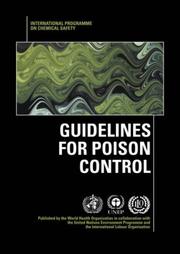
ISBN: 9241544872 Year: 1997 Publisher: Genève World Health Organization
Abstract | Keywords | Export | Availability | Bookmark
 Loading...
Loading...Choose an application
- Reference Manager
- EndNote
- RefWorks (Direct export to RefWorks)
Poison control centers --- Poisoning --- Poison Control Centers --- Environmental Monitoring. --- Drugs --- -Poison control centers --- -Poisoning --- -#A9808A --- Toxicological emergencies --- Toxicology --- Poison centers --- Emergency medical services --- Health facilities --- Accidental poisoning --- Medicaments --- Medications --- Medicine (Drugs) --- Medicines (Drugs) --- Pharmaceuticals --- Prescription drugs --- Bioactive compounds --- Medical supplies --- Pharmacopoeias --- Chemotherapy --- Materia medica --- Pharmacology --- Pharmacy --- Bio-Monitoring --- Biologic Monitoring --- Biomonitoring --- Environmental Surveillance --- Monitoring, Biological --- Biological Monitoring --- Monitoring, Environmental --- Bio Monitoring --- Monitoring, Biologic --- Surveillance, Environmental --- Environmental Restoration and Remediation --- Ecological Parameter Monitoring --- prevention & control. --- organization & administration. --- -Government policy --- Government policy --- Government policy. --- Environmental Monitoring --- #A9808A --- Toxicology&delete& --- organization & administration --- prevention & control --- Prevention and control --- Wastewater-Based Epidemiological Monitoring
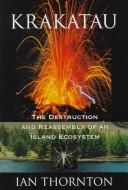
ISBN: 0674505689 9780674505681 9780674505728 0674505727 Year: 1996 Publisher: Cambridge, Mass. Harvard University Press
Abstract | Keywords | Export | Availability | Bookmark
 Loading...
Loading...Choose an application
- Reference Manager
- EndNote
- RefWorks (Direct export to RefWorks)
On August 27, 1883, the island of Krakatau in the Sunda Strait near Java erupted with a force nearly ten thousand times that of the atom bomb dropped on Hiroshima in 1945. Two-thirds of the island disappeared. When the pall of ash lifted, the toll in human lives stood at nearly 37,000 and more than 160 villages had been wiped away without a trace. All plant and animal life on Krakatau was obliterated. Nine months after the explosion, a French expedition searching for signs of life discovered a single spider that had crossed to the island on a balloon of silk. Life had returned to Krakatau. Scientists have been studying the island ever since. After the eruption, Krakatau provided a unique opportunity to study the colonization of a sterile area by plants and animals across a sea barrier and the gradual incorporation of the newcomers into the developing ecosystem. Krakatau: The Destruction and Reassembly of an Island Ecosystem is a comprehensive account of the reassembly of a tropical forest ecosystem over the past century. Ian Thornton tackles the many questions and controversies surrounding the eruption and its aftermath. He writes, "The natural healing process has followed the most extreme form of ecological destruction possible, total biological extirpation. Yet the islands surviving the 1883 eruption are covered in secondary forest, and over 200 species of plants, 70 species of vertebrates, and thousands of invertebrate species now inhabit these forests."
Island ecology --- Krakatoa (Indonesia) --- Krakotoa (Indonesia) --- Eruption, 1883. --- Krakotoa (Indonesia). --- Island ecology - Indonesia - Krakatoa. --- Ecology --- Environmental monitoring --- Volcanic eruptions --- Environmental Monitoring --- Volcanic Eruptions --- Volcanic Ash --- Volcanic Eruption --- Volcanic Gases --- Ash, Volcanic --- Eruption, Volcanic --- Eruptions, Volcanic --- Gases, Volcanic --- Environmental Surveillance --- Monitoring, Environmental --- Surveillance, Environmental --- Wastewater-Based Epidemiological Monitoring --- Environmental Restoration and Remediation --- Ecological Parameter Monitoring --- Bionomics --- Ecologies --- Environmental Psychology --- Conservation of Natural Resources --- Environmental Health --- Ecosystem --- Volcanoes --- Natural disasters --- Volcanism --- Biomonitoring (Ecology) --- Ecological monitoring --- Environmental quality --- Applied ecology --- Environmental engineering --- Pollution --- Balance of nature --- Biology --- Ecological processes --- Ecological science --- Ecological sciences --- Environment --- Environmental biology --- Oecology --- Environmental sciences --- Population biology --- Eruptions --- Measurement --- Monitoring --- Krakatao (Indonesia) --- Krakatau (Indonesia) --- Rakata (Indonesia) --- Insular ecology --- Islands
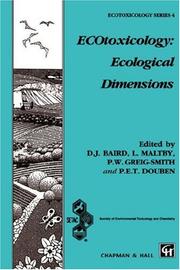
ISBN: 0412754908 9780412754708 0412754703 9780412754906 9400915411 Year: 1996 Publisher: London : Chapman and Hall,
Abstract | Keywords | Export | Availability | Bookmark
 Loading...
Loading...Choose an application
- Reference Manager
- EndNote
- RefWorks (Direct export to RefWorks)
The rooting of risk assessment firmly in ecological theory is a key subject currently being widely debated. This book reviews some of the more exciting developments in ecological theory which have applications in the field of ecotoxicology. A central theme in the book is a consideration of how to deal with chemical impacts on naturally variable ecological systems, and assessing and prioritising risks of long-term damage. Separate chapters deal with problems ranging from spatial to temporal variation, variation at the genome, population and community levels and the difficulty of predicting the behaviour of complex dynamics systems. The book is aimed at all working in the field of ecotoxicology, including students, where it is relevant for courses in ecotoxicology and environmental management courses.
General ecology and biosociology --- Toxicology --- Faune --- Fauna --- Flore --- Flora --- Facteur nuisible --- injurious factors --- Toxicité --- toxicity --- Impact sur l'environnement --- Environmental impact --- Dynamique des populations --- population dynamics --- Compétition biologique --- Biological competition --- Écologie --- ecology --- Biotope --- biotopes --- Écotoxicologie --- Ecotoxicology --- Environmental Monitoring. --- Ecology. --- Environmental Pollutants --- Environmental monitoring. --- 504.05 --- Pollution. --- Chemical pollution --- Chemicals --- Contamination of environment --- Environmental pollution --- Pollution --- Contamination (Technology) --- Asbestos abatement --- Bioremediation --- Environmental engineering --- Environmental quality --- Factory and trade waste --- Hazardous waste site remediation --- Hazardous wastes --- In situ remediation --- Lead abatement --- Pollutants --- Refuse and refuse disposal --- Biomonitoring (Ecology) --- Ecological monitoring --- Monitoring, Environmental --- Applied ecology --- Environmental Science --- Bionomics --- Ecologies --- Environmental Sciences --- Science, Environmental --- Sciences, Environmental --- Environmental Psychology --- Conservation of Natural Resources --- Environmental Health --- Ecosystem --- Bio-Monitoring --- Biologic Monitoring --- Biomonitoring --- Environmental Surveillance --- Monitoring, Biological --- Biological Monitoring --- Bio Monitoring --- Monitoring, Biologic --- Surveillance, Environmental --- Environmental Restoration and Remediation --- Ecological Parameter Monitoring --- toxicity. --- Unfavourable influences of human activities on the environment. Ecotoxicology --- Environmental aspects --- Control --- Measurement --- Monitoring --- Agrotechnology and Food Sciences. Toxicology --- Environmental aspects. --- Environmental Toxicology, Ecotoxicology --- Environmental Toxicology, Ecotoxicology. --- 504.05 Unfavourable influences of human activities on the environment. Ecotoxicology --- Environmental monitoring --- Environmental Monitoring --- Ecology --- Wastewater-Based Epidemiological Monitoring
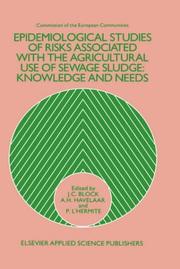
ISBN: 1851660356 9781851660353 Year: 1986 Volume: 10363 Publisher: London : Elsevier Applied Science Publishers,
Abstract | Keywords | Export | Availability | Bookmark
 Loading...
Loading...Choose an application
- Reference Manager
- EndNote
- RefWorks (Direct export to RefWorks)
Sewage sludge as fertilizer --- Health risk assessment --- Pathogenic microorganisms --- Health aspects --- Congresses --- Épandage des eaux usées --- Wastewater irrigation --- Pollution --- Épidémiologie --- Epidemiology --- Santé publique --- public health --- Agriculture --- agriculture --- Salmonella --- Virose --- Viroses --- Helminthose --- Helminthoses --- European Union --- France --- Environmental Monitoring. --- Epidemiologic Methods. --- Fertilizers --- Sewage --- Soil Microbiology. --- -Pathogenic microorganisms --- -Sewage sludge as fertilizer --- -Epidemiologic Method --- Epidemiological Methods --- Methods, Epidemiologic --- Epidemiological Method --- Method, Epidemiologic --- Method, Epidemiological --- Methods, Epidemiological --- Bio-Monitoring --- Biologic Monitoring --- Biomonitoring --- Environmental Surveillance --- Monitoring, Biological --- Biological Monitoring --- Monitoring, Environmental --- Bio Monitoring --- Monitoring, Biologic --- Surveillance, Environmental --- Environmental Restoration and Remediation --- Ecological Parameter Monitoring --- Disease-causing microorganisms --- Micro-organisms, Pathogenic --- Pathogens --- Microorganisms --- Medical microbiology --- Virulence (Microbiology) --- Assessment, Health risk --- Health hazard appraisal --- Health hazard assessment --- Health risk appraisal --- HRA (Public health) --- Human risk assessment --- Medicine, Preventive --- Public health --- Risk assessment --- Environmental health --- Microbiology, Soil --- Soil --- adverse effects. --- -Congresses --- methods --- microbiology --- virology --- -Bio-Monitoring --- Epidemiologic Method --- -adverse effects. --- Environmental Monitoring --- Epidemiologic Methods --- Soil Microbiology --- Health aspects&delete& --- adverse effects --- agriculture. --- Wastewater-Based Epidemiological Monitoring --- Sewage sludge as fertilizer - Health aspects - Congresses --- Health risk assessment - Congresses --- Pathogenic microorganisms - Congresses --- Workshop
Book
ISBN: 1282328689 9786612328688 0191552682 9780191552687 0191552690 9780191552694 9780199232895 019923289X 9780199232901 0199232903 1383036691 Year: 2009 Publisher: Oxford New York Oxford University Press
Abstract | Keywords | Export | Availability | Bookmark
 Loading...
Loading...Choose an application
- Reference Manager
- EndNote
- RefWorks (Direct export to RefWorks)
A systematic treatment of the statistical challenges that arise in environmental health studies and the use epidemiologic data in formulating public policy, at a level suitable for graduate students and epidemiologic researchers.
Environmental Monitoring --- Epidemiologic Methods --- Public Health Practice --- Investigative Techniques --- Public Health --- Environmental Exposure --- Environment and Public Health --- Environmental Pollution --- Analytical, Diagnostic and Therapeutic Techniques and Equipment --- Health Care --- Environmental Health --- Health & Biological Sciences --- Community-Based Distribution --- Contraceptive Distribution --- Delivery of Healthcare --- Dental Care Delivery --- Distribution, Non-Clinical --- Distribution, Nonclinical --- Distributional Activities --- Healthcare --- Healthcare Delivery --- Healthcare Systems --- Non-Clinical Distribution --- Nonclinical Distribution --- Delivery of Dental Care --- Health Care Delivery --- Health Care Systems --- Activities, Distributional --- Activity, Distributional --- Care, Health --- Community Based Distribution --- Community-Based Distributions --- Contraceptive Distributions --- Deliveries, Healthcare --- Delivery, Dental Care --- Delivery, Health Care --- Delivery, Healthcare --- Distribution, Community-Based --- Distribution, Contraceptive --- Distribution, Non Clinical --- Distributional Activity --- Distributions, Community-Based --- Distributions, Contraceptive --- Distributions, Non-Clinical --- Distributions, Nonclinical --- Health Care System --- Healthcare Deliveries --- Healthcare System --- Non Clinical Distribution --- Non-Clinical Distributions --- Nonclinical Distributions --- System, Health Care --- System, Healthcare --- Systems, Health Care --- Systems, Healthcare --- Pollution, Environmental --- Soil Pollution --- Pollution, Soil --- Environmental Pollutants --- Exposure, Environmental --- Environmental Exposures --- Exposures, Environmental --- Sentinel Species --- Community Health --- Environment, Preventive Medicine & Public Health --- Environment, Preventive Medicine and Public Health --- Health, Community --- Health, Public --- Preventive Medicine --- Education, Public Health Professional --- Investigative Technics --- Investigative Technic --- Investigative Technique --- Technic, Investigative --- Technics, Investigative --- Technique, Investigative --- Techniques, Investigative --- Health Practice, Public --- Health Practices, Public --- Practice, Public Health --- Practices, Public Health --- Public Health Practices --- Epidemiologic Method --- Epidemiological Methods --- Methods, Epidemiologic --- Epidemiological Method --- Method, Epidemiologic --- Method, Epidemiological --- Methods, Epidemiological --- Epidemiology --- Environmental Surveillance --- Monitoring, Environmental --- Surveillance, Environmental --- Wastewater-Based Epidemiological Monitoring --- Environmental Restoration and Remediation --- Ecological Parameter Monitoring --- methods --- Environmental Monitoring. --- Epidemiologic Methods. --- Environmentally induced diseases --- Statistical methods.
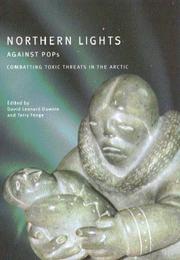
ISBN: 1282860828 9786612860829 0773570675 9780773570672 0773524827 9780773524828 0773524487 9780773524484 Year: 2014 Publisher: Montréal : McGill-Queen's University Press,
Abstract | Keywords | Export | Availability | Bookmark
 Loading...
Loading...Choose an application
- Reference Manager
- EndNote
- RefWorks (Direct export to RefWorks)
Northern Lights Against POPs tells the many-faceted scientific, policy, legal, and advocacy story that led to the Stockholm convention. Unique in its perspective, scope, and breadth, it reveals the key links among environmental and health science, international politics, advocacy, law, and global negotiations. Never before have public health concerns articulated by northern Indigenous peoples in Canada and throughout the circumpolar Arctic had such a direct impact on global policy-making. Authors show how research on POPs (persistent organic pollutants) in the Arctic from the mid-1980s influenced international negotiations and analyze the potential for the convention to be effective. Contributors include elected representatives, researchers, civil servants, Indigenous people who participated in the negotiations, and scientists who provided the compelling Arctic data that prompted the United Nations Environment Programme to sponsor negotiations. Contributors include David Anderson (Minister of the Environment, Canada); Nigel Bankes (University of Calgary); John Buccini (Consultant, former chair of the Global POPs Negotiations); Sheila Watt-Cloutier (Inuit Circumpolar Conference-Canada); Barry Commoner, Paul Woods Bartlett, Holger Eisl, Kimberly Couchot (Center for the Biology of Natural Systems, Queens College, City University of New York); Eric Dewailly (Laval University); David Downie (Director of Educational Partnerships, Columbia Earth Institute, Columbia University, New York); Terry Fenge (Inuit Circumpolar Conference-Canada); Henry Huntington (Consultant, Anchorage) and Michelle Sparck (Circumpolar Conservation Union, Washington, D.C.); Harriet Kuhnlein, Laurie Chan (Centre for Indigenous Peoples' Nutrition and Environment, McGill University), and Olivier Receveur (formerly Centre for Indigenous Peoples' Nutrition and Environment, McGill University); Lars-Otto Reiersen (Arctic Monitoring and Assessment Programme Secretariat,Oslo); Henrik Selin (Massachusetts Institute of Technology); David Stone, Russell Shearer (Northern Contaminants Program, Department of Indian Affairs and Northern Development, Canada); Klaus Topfer (Executive Director, United Nations Environment Programme).
Arctic regions -- Environmental conditions. --- Electronic books. --- Organic compounds -- Environmental aspects -- Arctic regions. --- Organic compounds -- Health aspects -- Arctic regions. --- Persistent pollutants -- Arctic regions. --- Persistent pollutants -- Health aspects -- Arctic regions. --- Stockholm Convention on Persistent Organic Pollutants -- (2001). --- Persistent pollutants --- Organic compounds --- Arctic Regions --- Environmental Monitoring --- Organic Chemicals --- Environmental Pollutants --- Pesticides --- Agrochemicals --- Chemicals and Drugs --- Geographic Locations --- Environmental Exposure --- Specialty Uses of Chemicals --- Toxic Actions --- Public Health Practice --- Geographicals --- Environmental Pollution --- Public Health --- Chemical Actions and Uses --- Environment and Public Health --- Health Care --- Environmental Sciences --- Environmental Engineering --- Civil & Environmental Engineering --- Earth & Environmental Sciences --- Engineering & Applied Sciences --- Health Practice, Public --- Health Practices, Public --- Practice, Public Health --- Practices, Public Health --- Public Health Practices --- Environmental Pollutants, Noxae, and Pesticides --- Toxic Action --- Action, Toxic --- Actions, Toxic --- Community-Based Distribution --- Contraceptive Distribution --- Delivery of Healthcare --- Dental Care Delivery --- Distribution, Non-Clinical --- Distribution, Nonclinical --- Distributional Activities --- Healthcare --- Healthcare Delivery --- Healthcare Systems --- Non-Clinical Distribution --- Nonclinical Distribution --- Delivery of Dental Care --- Health Care Delivery --- Health Care Systems --- Activities, Distributional --- Activity, Distributional --- Care, Health --- Community Based Distribution --- Community-Based Distributions --- Contraceptive Distributions --- Deliveries, Healthcare --- Delivery, Dental Care --- Delivery, Health Care --- Delivery, Healthcare --- Distribution, Community-Based --- Distribution, Contraceptive --- Distribution, Non Clinical --- Distributional Activity --- Distributions, Community-Based --- Distributions, Contraceptive --- Distributions, Non-Clinical --- Distributions, Nonclinical --- Health Care System --- Healthcare Deliveries --- Healthcare System --- Non Clinical Distribution --- Non-Clinical Distributions --- Nonclinical Distributions --- System, Health Care --- System, Healthcare --- Systems, Health Care --- Systems, Healthcare --- Community Health --- Environment, Preventive Medicine & Public Health --- Environment, Preventive Medicine and Public Health --- Health, Community --- Health, Public --- Preventive Medicine --- Education, Public Health Professional --- Pollution, Environmental --- Soil Pollution --- Pollution, Soil --- Specialty Chemicals and Products --- Exposure, Environmental --- Environmental Exposures --- Exposures, Environmental --- Sentinel Species --- Agrichemicals --- Chemicals, Agricultural --- Agrichemical --- Agricultural Chemical --- Agricultural Chemicals --- Agrochemical --- Chemical, Agricultural --- Pesticide --- Pollutants --- Pollutants, Environmental --- Environmental Pollutant --- Pollutant --- Pollutant, Environmental --- Radiation Exposure --- Organic Chemical --- Chemical, Organic --- Chemicals, Organic --- Environmental Surveillance --- Monitoring, Environmental --- Surveillance, Environmental --- Wastewater-Based Epidemiological Monitoring --- Environmental Restoration and Remediation --- Ecological Parameter Monitoring --- Compounds, Organic --- Organic chemicals --- Carbon compounds --- Persistent chemicals --- Environmental aspects --- Health aspects
| Listing 1 - 7 of 7 |
Sort by
|

 Search
Search Feedback
Feedback About UniCat
About UniCat  Help
Help News
News